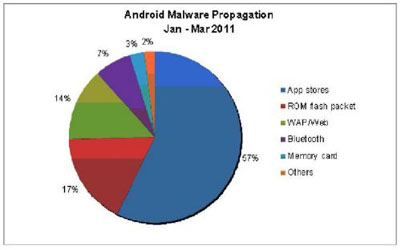Chinese Android Users under Mobile Attacks
China received about 64% of the world’s mobile attacks on Android devices in the first quarter of 2011, according to a mobile security report released Wednesday by NetQin Mobile Inc., a mobile security services company.
Ranked second on the list is the US with 7.6%, followed by Russia, India, and Indonesia respectively with 6.1%, 3.4% and 3.2%. NetQin warns that Android users are facing more severe mobile challenges than ever.
According to NetQin, about 2.53 million Android users were infected with mobile viruses or malware in the first quarter of 2011, with most of them occurring in China, which is partly due to the easy availability of “white box” phones (open phones that are not tied to particular carriers) and a general lack of mobile security awareness among mobile phone users.
[ Also Read: Why Marketers are Chasing the Mobile Mirage ]The report says “white box” phones often run outdated versions of mobile software and are not provided with security support from legal carriers.
The lack of mobile security awareness further adds fuel to the flames, as users often ignore protective measures when engaged in mobile activities, such as using mobile payment channels, web browsing or clicking on URLs from unknown sources, thus allowing more mobile viruses and malware to intrude their mobile devices.
[ Also Read: 10 Hot Mobile Apps You Can’t Ignore ]In the consumer pool sampled by NetQin, the reported results of these mobile threats mainly include: malicious fee deduction (up to more than 45%), privacy theft (about 30%), Backdoor (about 12%), fee consumption (about 7%), rogueware (about 5%) and malware that disrupts normal operation of systems (about 1%).
NetQin reports that Android Market is the main source of mobile threats, and is responsible for 57% of them. Other sources include unbranded devices and downloading from WAP and WWW websites.
[ Also Read: China Super Girl Reality Show on the Web ]Most of the infected phones are running Froyo, the Android OS V2.2, accounting for 45% of the total, followed by Eclair (Android OS V2.1) and Gingerbread (Android OS V2.3) respectively with 34% and 16%.
According to NetQin, the popularity of Froyo devices is probably to blame for its becoming the main target of mobile attacks. It says the good news is that Android OS V1.6 and its previous versions are seldom hit, accounting for less than 5%.
The report also addresses the vulnerability of the Android OS, such as acquisition of root access, weak scrutiny of apps before their entry in to Android Market and the embedding of malware.
[ Also Read: Are Small Businesses Cybercrime Targets? ]DroidDream had Google remove more than 50 offending apps from Android Market earlier this year and is a good illustration of the problem, says the report.
NetQin believes that future mobile security would rely more on “cloud computing“, especially the “Cloud + End” model, which is capable of responding promptly to mobile threats, from data collection and risk ranking to the provision of a final solution.
[ Also Read: Ali Shadman Reveals the Secrets of Cloud Computing ]NetQin is now providing services to users with the “Cloud + End” model, which is said to be the trend-setter in the area of mobile security technology development.
Headquartered in Beijing China, NetQin Mobile Inc. is a leading provider of consumer-centric mobile Internet services focusing on security and productivity.
💛 Support Independent Journalism
If you find RMN News useful, please consider supporting us.




